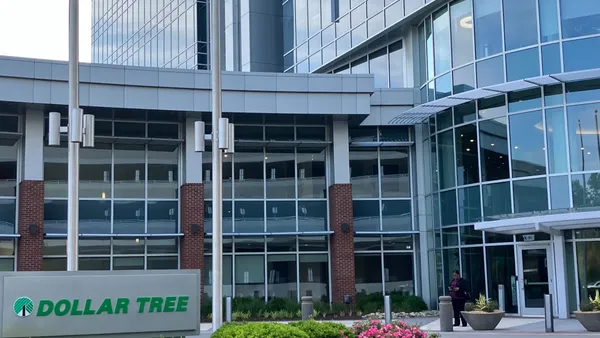Inside Sam's Club's new Southern California fulfillment center, autonomous mobile robots guided by artificial intelligence help the company keep up with booming e-commerce orders.
Sam's Club leased the 753,000-square-foot distribution building in Perris, California, near Los Angeles earlier this year. The operation is dedicated to e-commerce fulfillment and will serve as an innovation lab as well. Sam's Club's e-commerce sales hit $363 million at the end of the third quarter of 2020, compared to $277 million the previous year.
Inside, robots driven by GreyMatter software from Atlanta-based GreyOrange scuttle among the inventory racks. Items are stored on the racks in cubbies or bins. Robots grab and move products to pick stations where workers take the items from the robot and pack them in boxes for shipment.
It's an example of a goods-to-person picking system in which the robots learn continuously and reduce stress on human labor, according to Sam's Club executives, at a time when e-commerce orders are taking off.
Robots get smarter with every pick
GreyOrange's software continuously adjusts the inventory location to be the most efficient and fastest. If the system identifies two items that are often ordered together – say a fleece pullover and a pair of slacks – those items will be placed closely together on the rack to be grabbed in one move. When the weather changes and fewer consumers order the fleece pullover, the robots will move that product to another location in the warehouse.
"The technology in this building optimizes these processes and helps improve the workload, allowing associates more time to upskill and train for cutting-edge opportunities."

Mike Petterborg
General Manager of the Sam's Club fulfillment center
"We call it inventory in motion, compared to the traditional model where you do slotting every month or two," said Jeff Cashman, senior vice president and COO of GreyOrange. "This is fundamentally real-time slotting."
The system can identify and prioritize orders based on shipping commitments to customers and the cut-off times for turning over packages to parcel carriers. It's a real-time system instead of batch or wave picking strategies found in many warehouses. The system also routes items to be packed to faster workers or open stations to improve efficiency.
"The system can pop up an order to the top of the pool so that it makes it on the right UPS truck and it gets to the customer on time," Cashman said. "The machine learning behind the AI is always thinking about how to reach the lowest cost."
The fulfillment center recently introduced Packing Visualization, Sam's Club's patented 3D visualization packing software. It simplifies the previously manual process by using automated intelligence and illustrations to show associates the easiest and most accurate way to place items.
After the products have been placed on the packing table, associates simply press a button for the items to be measured and precisely packed into fit-to-order cartons. Then the order is ready to be sorted and sent off to awaiting members.
"By employing automated fit-to-order packaging technology and 3D visualization in our fulfillment centers, Sam's Club reduces redundant work for our associates, prevents damage to members' orders, and helps us lower our carbon footprint and the amount of shipping material utilized," Vinod Bidarkoppa, senior vice president and chief technology officer, said in a company blog post.
Robots help solve the labor puzzle
Sam's Club planned to hire 2,000 permanent supply chain workers and increase pay by $2 per hour during the holiday peak.
Reducing wear and tear on existing employees was a priority for Sam's Club.
"Fulfillment center roles can be physically demanding, and the work can be repetitive," Mike Petterborg, general manager of the fulfillment center, said in the post.
Robotics can replace 50% to 70% of the labor for warehouse picking, depending on the type of inventory and order levels, Cashman said.
The picking stations where employees work are typically six to nine feet apart, so they naturally support social distancing directives, Cashman noted. And an automated warehouse uses fewer people overall.
E-commerce is taking over
Like many companies, Sam's Club has faced a boom in e-commerce orders. The company has converted closed stores in Chicago and Memphis into fulfillment centers. This year, the retailer launched the Ship-from-Club service at 100 locations. Employees fulfill online orders from the store's inventory, accounting for about 20% of all e-commerce orders. The warehouse club also offers curbside pickup at all 597 locations.
"Freed from a fixed automation infrastructure, our customers can design the workflows that best suit their order characteristics and demand patterns."

Jeff Cashman
Senior Vice President and COO of GreyOrange
The massive shift to e-commerce during the pandemic has accelerated companies' plans for automation. "Instead of a 5- to-7-year window, it's now 3 to 5 years or less," Cashman said. "They're concerned about not being prepared for the shift to e-commerce or the next crisis."
The GreyOrange automation system can be installed in existing facilities in any type of real estate such as stores, distribution centers, warehouses and fulfillment centers, Cashman said.
The robots are guided by bar codes placed on the floor that define the "field," or the area where the robots operate.
"Freed from a fixed automation infrastructure, our customers can design the workflows that best suit their order characteristics and demand patterns," Cashman said.
The number of robots varies based on the site requirements. Small click-and-collect sites operate with as few as three robots, while a large distribution center may have more than 500 units, Cashman said. The software can accommodate large numbers of robots from GreyOrange and other vendors in a single software instance, reducing cost and complexity.
Users can add robots for peak season or support product introductions or promotions, and then downsize and return to the previous level after the peak.
This story was first published in our weekly newsletter, Supply Chain Dive: Operations. Sign up here.
This story was updated with additional details from Sam's Club.




















